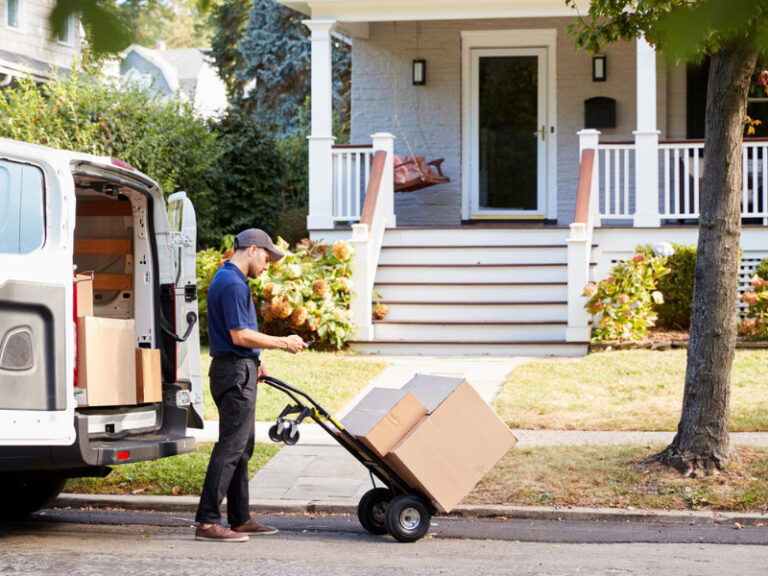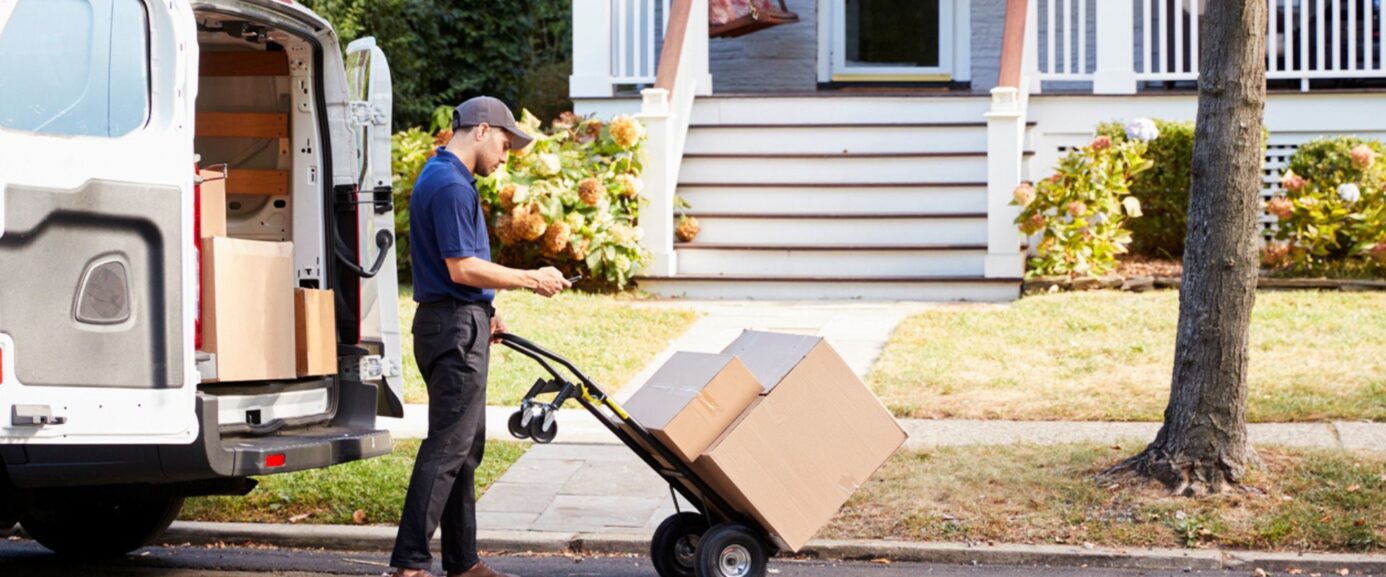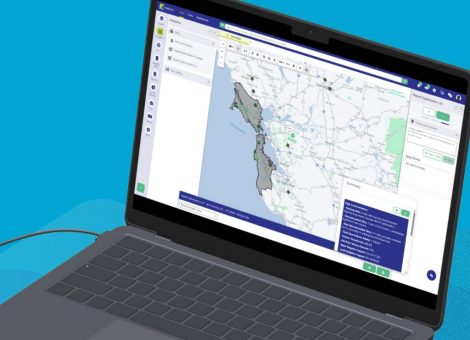First party vs. third party home delivery

The delivery supply chain industry has seen explosive growth and fragmentation in the past five years. The shift, in the first instance, has been technology enabled. The ecommerce marketplace model coupled with the growth of platforms such as DoorDash and UberEats, has meant home delivery can be faster purely due to the scale economies and a ready supply of drivers seeking flexible employment.
The pandemic’s influence on consumer buying habits – partly from convenience, partly from necessity borne of restrictions on in-store visits – has accelerated the adoption of delivery across retail segments. Those that did not have their own delivery operation – or could not meet the explosion in demand – quickly pivoted to using third party providers.
In doing so, many companies outsourcing home delivery handed over ownership of parts of their data-gathering capabilities and customer experience. But on the flip side, they’re able to scale quicker with lower overheads. So, let’s examine the impact of third-party delivery versus an in-house model. Does the march towards ever speedier and lower cost delivery models come at a cost? We asked Dave Huntoon and Kayla Kurtz to examine the pros and cons.
Data considerations
Many third-party delivery companies are very strict concerning their unwillingness to share customer data with the restaurant or retailer they are serving. There are a number of reasons for this, including the ability to monetize the underlying data. However, the primary consideration is that the delivery company wants to own the customer relationship, and providing a restaurant or retailer with detailed customer data keeps the relationship firmly in the restaurant’s hands. With our strong belief in making data-driven decisions, lost visibility with regards to customer data is something Kalibrate would generally advise against. Outsourcing delivery often means giving up the depth of insight easily gathered through if the delivery process is controlled by the restaurant, including customer patronage frequency, customer address (with the ability append household demographic and psychographic characteristics), and overall customer value.
One simple example concerns cannibalization – how big a cannibalization or sales transfer impact will a proposed nearby location have on an existing restaurant. This is typically calculated by determining where existing customers are coming from on a sector-by-sector basis, and estimating the proportion of customers from each sector that will elect to patronize the new location due to locational convenience. However, if delivery sales through a third-party provider represent a significant proportion of revenue and the operator doesn’t know where those delivery customers reside, it becomes difficult to accurately predict anticipated cannibalization.
The enormous caveat in this instance is that retailers and restaurant operators need to be driven by the needs of their customers. And you can’t collect any customer data if your customers are heading to a competitor. Here lies the challenge. If your customers expect their food order by 7.30pm or their new outfit by the next day, failing to meet that need because you’re unwilling to give up data gathered from your delivery supply chain only means loss of custom.
An additional data consideration comes from what happens to your customer data. Third-party delivery operators aren’t omnidirectional in terms of their revenue streams. Handling vast amounts of customer data quickly becomes monetizable. Most real estate professionals know this because they’re subscribed to a wealth of data sources originating from or enriched by outsourced delivery companies.
But once your data is handed over, you relinquish control over how large parts of that data can be used thereafter. Licensing agreements and other contractuals give a modicum of limitations but, for the most part, your data becomes another tool in the kit of real estate professionals trying to grow and win share for their brand – some of them your competition.
Quality control and brand considerations
The experience of customers is another key factor influencing delivery decisions. Yes, outsourcing may give speedier delivery and free up resources elsewhere, but if it’s to the detriment of customer experience, the collateral impact on your brand should give many pause for thought.
This concern is particularly acute in the restaurant space. Customers receiving sub-standard food, either because it’s been damaged in transit, is incomplete, or has taken too long and arrived cold, may well blame the restaurant rather than the delivery agency. And, in most cases, rightly so. After all, the vendor has selected the agent based on its ability to deliver a product on time and in the appropriate condition. If an exception becomes a rule, customers may attribute the loss of quality to cost cutting or a lack of due diligence when selecting the delivery partner.
A further consideration is the trade area in which you’re operating. Third party vendors often determine the geographies they’re willing to serve for each market. If that’s smaller than the one you’d choose for your concept, you may sell less because you cannot reach customers. Conversely, if it’s too large, your product may not arrive as quickly as the customer expects – or what you would want – because it’s is being delivered to geographies beyond what you’d define as a realistic trade area. Pizza chains with in-house delivery capabilities have long adhered to strict delivery timeframes, knowing that delivering cold pizzas will accrue to their detriment.
In every vertical, outsourcing the delivery leg of the customer journey means losing that ownership of the brand experience you strive so hard to fulfil everywhere else. It’s a dilemma we hear repeatedly – again, particularly from restaurant operators. The hyper competitive delivery space, with an operating model that often rewards its agents by delivery count, means drivers can be incentivized to take the most efficient drive-time route, rather than linearly by order or expected delivery times. An additional factor to consider is that third party delivery employees can select orders based on tip amount, which is given prior to delivery, and decline those based on distance.
Brands spend vast amounts on location, product, and promotion. All that investment can be undone – at that most vital time, receiving the product in their hands – if the customer feels let down by a quality of service from a third party. To a delivery driver, a package containing a $5 shirt weighs and feels exactly the same as a $200 shirt. To the customer, the expectation of how that package will be handled, transported, and delivered (or left for the owner to find on their doorstep), may be totally different.
Operators that own their whole delivery chain also do not contend with being placed side-by-side with their biggest competition when customers browse a third-party application. Conversely, they also do not appear on third parties for customers who are undecided on exactly what they want to order.
But the main counterpoint to in-house – and why so many brands do outsource – is being able to fulfil orders quickly at scale. As we’ve established, customers value speed and convenience – you might be able to deliver a perfect product with an in-house operation, but can you do 100, 200, or 500 of them every day if that’s how you plan to grow? If you can’t, chances are someone else will. That’s why handing over a portion of customer experience can still be worthwhile from a brand perspective – no downtime, reliable delivery is still important. This balancing act is what many retailers wrestle with. Some will have negative experiences outsourcing and bring in-house, others will go in the opposite direction.
Ultimately, the weighting you give to customer experience – of which delivery is a critical component – should be driven by the brand experience you intend to create. Concepts focused on speed and volume – quick service restaurants or fast fashion – can rely on third party with greater confidence than others. Premium brands that put experience front and center – and have customers valuing exceptional quality over speed of delivery – will continue to lean towards in-house.
Cost considerations
While every retailer would love to offer the most tailored, personalized service, owning every part of their customer’s journey, reality dictates that you will have to outsource parts of the experience.
The growth of delivery platforms and the marketplace model means that even the smallest operators can offer speedy delivery at a scale that would be cost prohibitive in the recent past. For most, the logistics of maintaining a delivery fleet, costs of staffing in drivers and operations, and insurance risk/pricing are unaffordable. The capital can be better spent on higher quality product or produce, competitive pricing, or promotional activity.
Brands favoring in-house also tend to have additional costs of leveraging third-party platforms to manage their delivery operation internally. Although this part of the journey is hidden from the customer, there are costs associated with syncing orders with drivers, adding third party “Buttons” for delivery options at restaurant locations, and negotiated percentage fees per order when placed through a third-party vendor.
But there are cost considerations for outsourcing too – particularly impacting margin. Third party delivery platforms in the restaurant space take a good percentage of each order they process and fulfill.
That said, the reason so many operators will favor outsourcing is scale affordability.
Kalibrate says
Brands that invest in knowing their customers – the values, expectations around quality and convenience, incomes, buying habits – are best placed to make the best decision about the home delivery model fit for their concept. That’s why many brands with the scale to manage an in-house operation opt to do so.
Although it’s not just knowing your customers; it’s understanding demand too. If you’re a restaurant chain and all your orders come between 5pm-9pm, it might seem logical to simply bring the delivery in-house and focus your rostering there. But recruitment and retention have been challenging in recent years – and does your concept perform if you suddenly cannot fulfill orders at scale due to loss of staff? In this example, a third party becomes the obvious solution.
Both retailers and restaurant brands must place the expectations of their customer at the heart of their decisions around home delivery models. Failure to deliver a high-quality service or a speedy, convenient one will have different impacts for brands depending on the profile of their customers and the brand experience they’re aiming to achieve.
Navigating the trade-offs associated with third-party and in-house, then aligning it to where your brand is today – and where you want to be tomorrow – is a challenging prospect. There’s no right answer for all but leaning on quality insight gives you the best chance of finding the right answer for your concept.
Read more articles about:
Location intelligenceSubscribe and get the latest updates
You may unsubscribe from our mailing list at any time. To understand how and why we process your data, please see our Privacy & Cookies Policy
Related resources
Meet the Kalibrate team
Delivering the Kalibrate Standard: Elizabeth Butler
This blog series explores how members of our team help our clients answer their most challenging questions. Here, we...

Location intelligence
Sister store impact: The need for sales transfer studies
Will your expansion hurt existing stores? Find out first.


